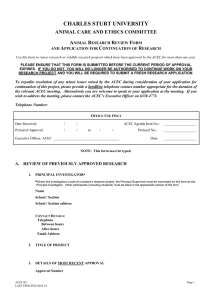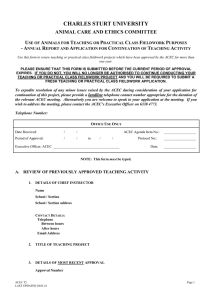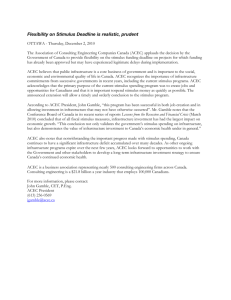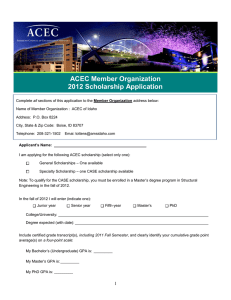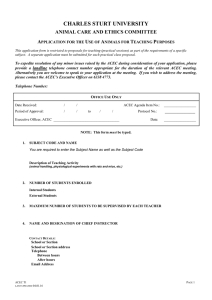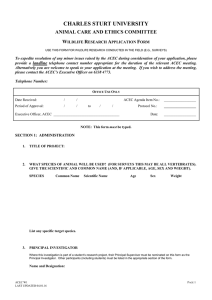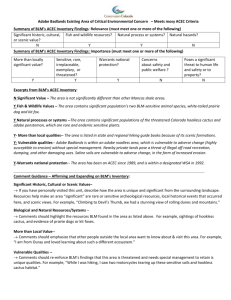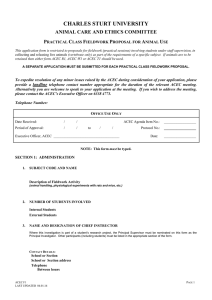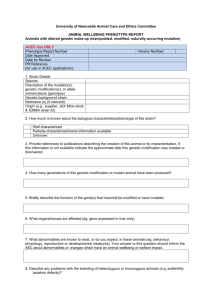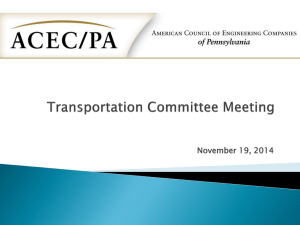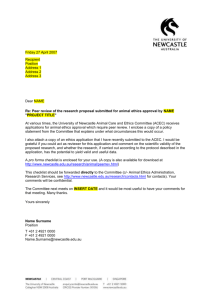ACEC-R1
advertisement
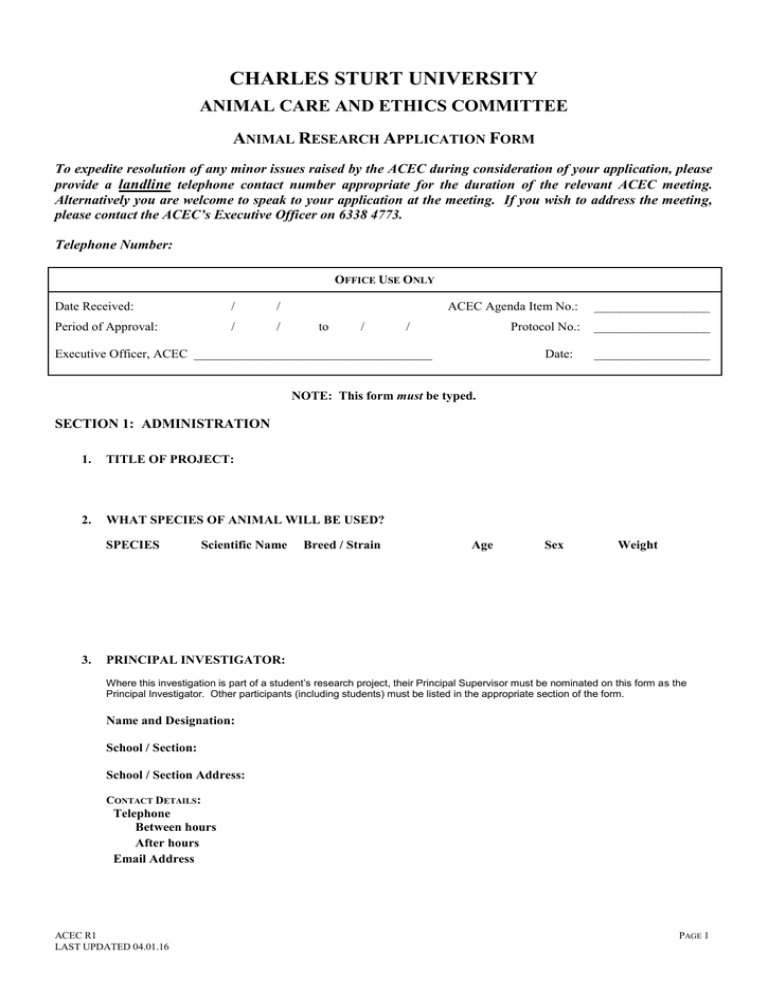
CHARLES STURT UNIVERSITY ANIMAL CARE AND ETHICS COMMITTEE ANIMAL RESEARCH APPLICATION FORM To expedite resolution of any minor issues raised by the ACEC during consideration of your application, please provide a landline telephone contact number appropriate for the duration of the relevant ACEC meeting. Alternatively you are welcome to speak to your application at the meeting. If you wish to address the meeting, please contact the ACEC’s Executive Officer on 6338 4773. Telephone Number: OFFICE USE ONLY Date Received: / / Period of Approval: / / to / ACEC Agenda Item No.: __________________ Protocol No.: __________________ / Executive Officer, ACEC _____________________________________ Date: __________________ NOTE: This form must be typed. SECTION 1: ADMINISTRATION 1. TITLE OF PROJECT: 2. WHAT SPECIES OF ANIMAL WILL BE USED? SPECIES 3. Scientific Name Breed / Strain Age Sex Weight PRINCIPAL INVESTIGATOR: Where this investigation is part of a student’s research project, their Principal Supervisor must be nominated on this form as the Principal Investigator. Other participants (including students) must be listed in the appropriate section of the form. Name and Designation: School / Section: School / Section Address: CONTACT DETAILS: Telephone Between hours After hours Email Address ACEC R1 LAST UPDATED 04.01.16 PAGE 1 4. DATES FOR APPROVAL (Use DD/MM/YY format) From: To: For ongoing work where methodology does not change, you may apply for an approval period of up to three (3) years after the proposed commencement date, as the ACEC can approve ongoing projects for up to 3 years subject to receipt of annual reports (ACEC R2). Please note that Annual Review Forms are required under the Australian Code for the Care and Use of Animals for Scientific Purposes (2.4.34) 5. DESCRIPTION OF RELATIONSHIP OF PRINCIPAL INVESTIGATOR WITH THE INSTITUTION: (Employee, Collaborative Research, Independent of CSU, etc.) 6. A. HAS AN EXTERNAL ORGANISATION AGREED TO SUPPORT THIS APPLICATION, OR HAS AN APPLICATION FOR EXTERNAL SUPPORT BEEN LODGED? Choose one: Yes No If YES, provide details (i.e., name of the organisation and date of application, and whether the application has, to date, been successful.) B. IF A FUNDING APPLICATION IS NOT SUCCESSFUL, WILL THE PROJECT STILL PROCEED? Choose one: Yes No 7. A. IS THIS APPLICATION FOR A NEW PROJECT? Choose one: Yes No B. IS THIS APPLICATION FOR A PROJECT WHICH BEEN, PREVIOUSLY OR SIMULTANEOUSLY, SUBMITTED TO THIS OR ANOTHER ETHICS COMMITTEE? Choose one: Yes No If YES, provide reasons for resubmission or simultaneous submission, and the name of the AEC or AECs and approval numbers where appropriate. C. IS THIS APPLICATION FOR A SIGNIFICANTLY REVISED CURRENT PROTOCOL? Choose one: Yes No If YES, quote the approval number, species and number of animals used to date. 8. ARE YOU USING (Please delete the response that does not apply): X-Radiation Yes/No Gamma Radiation Yes/No Laser Radiation Yes/No Recombinant DNA Technology Yes/No Infectious materials Yes/No Toxic materials Yes/No ACEC R1 LAST UPDATED 04.01.16 PAGE 2 Carcinogenic materials Yes/No Other harmful agents Yes/No If YES: A. Will precautions be taken in accordance with statutory requirements and have relevant personnel been informed? Choose one: Yes No B. Has the appropriate authority or licence from the applicable University Compliance Committee been obtained? (Approval from the University Biosafety Committee or University Radiation Safety Committee, etc.) Choose one: 9. Yes No Not Applicable DOES THE PROJECT INVOLVE NATIVE, SPECIALLY IMPORTED OR PROTECTED SPECIES? Choose one: Yes No If YES: A. Have the relevant licences been obtained from the National Parks and Wildlife Services or other authorities? Choose one: Yes No B. Permit Type and Number 10. HAVE ANY OF THE PEOPLE PARTICIPATING IN THE PROJECT HAD ANY ANIMAL RESEARCH AUTHORITY OR ANIMAL SUPPLIER’S LICENCE CANCELLED? Choose one: Yes No If YES, please provide details including the name of the person, the date on which the authority or licence was cancelled, who cancelled the authority and the reason for cancellation: Name of Staff Member Date Authority / Licence Cancelled Name of Cancelling Body Reason for Cancellation of Authority / Licence SECTION 2: JUSTIFICATION FOR ANIMAL USE AIMS OF THE PROJECT IN LAY TERMS The Code of Practice states that “Animal experiments may only be performed when the scientific merit justifies the use of animals”. Your answer is crucial for the assessment of scientific merit and the necessity of animal use. USE LAY TERMS AND EVERYDAY ENGLISH as much as possible; terms that will be understood by a member of the Committee without a scientific background. 11. DESCRIBE THE AIMS OF THE PROJECT IN LAY TERMS A PERSON WITHOUT A SCIENTIFIC BACKGROUND WILL UNDERSTAND. COMMENT ON THE SIGNIFICANCE OF THE RESEARCH ACEC R1 LAST UPDATED 04.01.16 PAGE 3 WHICH YOU BELIEVE JUSTIFIES THE USE OF ANIMALS. SPECIFY WHAT YOU HOPE TO ACHIEVE. PLEASE GIVE THE BACKGROUND TO THIS PROJECT, WITH A SUPPORTING LIST OF KEY REFERENCES. 12. IF THE PROJECT REPEATS PREVIOUSLY-REPORTED EXPERIMENTS, GIVE THE REASONS FOR THE EXPERIMENTS BEING REPEATED. REASONS FOR ANIMAL USE 13. A. WHY IS IT NECESSARY TO USE ANIMALS IN THIS EXPERIMENT? B. WHAT ALTERNATIVES TO ANIMAL USE HAVE BEEN CONSIDERED AND WHY IS IT NOT POSSIBLE TO USE THESE? 14. WHY HAS THIS SPECIES OF ANIMAL (AND, IF APPLICABLE, AGE, SEX AND WEIGHT) BEEN CHOSEN? 15. A. HOW MANY ANIMALS WILL BE REQUIRED? B. EXPLAIN, ON THE BASIS OF EXPERIMENTAL DESIGN, WHY THIS NUMBER OF ANIMALS WILL BE REQUIRED Wherever possible, a power analysis with alpha value should be included or, if this is not possible, a comprehensive explanation. SECTION 3: ETHICAL CONSIDERATIONS AN ASSESSMENT OF THE IMPACT ON ANIMAL WELL-BEING SEQUENCE OF EVENTS 16. GIVE DETAILS (SEQUENTIALLY) ON WHAT HAPPENS TO THE ANIMAL(S) FROM THE TIME YOU OBTAIN THEM UNTIL USE OF THE ANIMAL(S) IS COMPLETE. A flow chart or Sequence of Events table may assist in making this information clear. Please list any Standard Operating Procedures which are to be used – please refer to the ACEC Register of Standard Operating Procedures on the ACEC website for a complete list of Standard Operating Procedures (SOPs) already approved by the Animal Care and Ethics Committee. If you are submitting a new Standard Operating Procedure for approval by the Committee, please insert “None- New for Approval” under “SOP Number”. SOP Number ACEC R1 LAST UPDATED 04.01.16 SOP Name PAGE 4 If any media-related activities arise from this research (for example, photo shoots for newspaper / magazine / journal features or filming for documentaries or television news features), you will need to advise the Animal Care and Ethics Committee and submit photographs or filming to the Committee as part of the animal use associated with this project. IMPACT 18. A. IDENTIFY ALL FACTORS AND PROCEDURES THAT MAY HAVE AN IMPACT ON AN ANIMAL’S WELL-BEING, AND PROVIDE DETAILS OF HOW YOU WILL MONITOR THE IMPACT. Factors may include handling, housing, etc., as well as specific experimental procedures. Refer to the CHECKLIST at the end of this application form to ensure all details have been considered and refer to published standard operating procedures where appropriate. B. DESCRIBE EACH FACTOR OR PROCEDURE AND DETAIL HOW ANY ADVERSE IMPACT WILL BE MINIMISED. Details should include treatment substances, dose rates, routes of administration, anaesthetic and analgesic regimes, etc., as applicable. Refer to the CHECKLIST to ensure that all details have been considered. ANIMAL MONITORING 19. WHO WILL MONITOR THE ANIMALS A. During weekdays? Please tell the Committee what experience the person has relevant to care of the species to be used in the project, and how many years’ experience with those animals that nominee has. NAME QUALIFICATIONS EXPERIENCE WITH SPECIES USED B. At night (If applicable)? Please tell the Committee what experience the person has relevant to care of the species to be used in the project, and how many years’ experience with those animals that nominee has. NAME QUALIFICATIONS EXPERIENCE WITH SPECIES USED C. During weekends and holidays? ACEC R1 LAST UPDATED 04.01.16 PAGE 5 Please tell the Committee what experience the person has relevant to care of the species to be used in the project, and how many years’ experience with those animals that nominee has. NAME 20. QUALIFICATIONS EXPERIENCE WITH SPECIES USED DESCRIBE HOW THE ANIMALS WILL BE MONITORED A. While the procedures are being carried out. Include frequency and methods used. B. For the duration of the project. Include frequency and methods used. ANIMAL HOUSING AND MANAGEMENT 21. PROVIDE FULL DETAILS OF A. Where animals will be housed: B. The maximum and minimum number of animals per cage / pen: C. The type of housing to be provided: D. Where procedures will be performed: E. What animals will be fed, and how often will they be fed? F. Who will be responsible for the management of emergencies, and how you will ensure that the nominee(s) can be contacted (Refer also to Question 28): G. Outline the contingency measures you have in place for the management of injured animals, or animals extraneous to the project. H. Have you consulted with the relevant animal house Manager on the detail of how the animals are to be housed, fed, watered and have environmental enrichment, etc., provided for them during this project? Choose one: Yes No DECLARATION BY MANAGER, ANIMAL HOUSE / MANAGER, HOLDING FACILITY: Please cross out the sections below that do not apply ACEC R1 LAST UPDATED 04.01.16 PAGE 6 I confirm that housing is available in the Animal House / Holding Facility for the number of animals requested for the research period nominated, and that the Animal House / Facility staff can provide adequate maintenance and care of the animals during that time OR Housing will be available for _______ animals in the Animal House / Holding Facility for the research period nominated. Additional housing will be provided at: _________________________________________________________________________________ There will be staff at both facilities to provide adequate maintenance and care of the animals during that time. OR Housing and staff to provide adequate maintenance and care of the animals are not available in the Animal House / Holding Facility for the animals requested during the research period nominated. Name: _______________________________________________________ Signed: _______________________________________________________ Animal House / Facility name: Date: ____________________________________________________________ _______________________________________________________ DECLARATION BY PRINCIPAL INVESTIGATOR: I have personally inspected the animal housing / holding facility to be used during this research project, and I am satisfied in regard to the smooth running of the housing facility for the duration of the project. Signature: _______________________________________________________ SOURCE 22. FROM WHERE WILL THE ANIMALS BE OBTAINED? DURATION 23. WHAT WILL BE THE MAXIMUM TIME THAT AN INDIVIDUAL ANIMAL WILL BE HELD FOR IN THIS EXPERIMENT? RE-USE 24. DOES THIS PROJECT INVOLVE THE USE OF ANY ANIMALS THAT HAVE BEEN THE SUBJECT OF PREVIOUS RESEARCH? Choose one: Yes No ACEC R1 LAST UPDATED 04.01.16 PAGE 7 If YES, what has previously been done to these animals? Include project name(s) and identification number(s). FATE OF ANIMALS 25. WHAT WILL HAPPEN TO THE ANIMALS AT THE COMPLETION OF THE PROJECT? 26. WILL FACTORS AFFECTING ANIMALS DETERMINE THE ENDPOINT OF THE PROJECT? (tumour size, maximum weight loss, etc.) Choose one: Yes No If YES, give details. If NO, what will be the endpoint? 27. IF ANIMALS ARE TO BE EUTHANASED A. How will this be done? B. Where will euthanasia be carried out? C. Who will carry out the procedure, and what is their experience in the technique to be employed? D. Could animal tissue be shared with other Investigators? TECHNICAL 28. LIST THE QUALIFICATIONS AND EXPERIENCE OF ALL PERSONNEL WHO WILL BE PARTICIPATING IN THE ANIMAL COMPONENTS OF THE PROJECT. Detail whether the experience is with the species being used, as well as whether the experience is with the procedures being undertaken. Please tell the Committee what experience the person has relevant to the procedure to be performed, and how many years’ experience in that field that nominee has. POSITION NAME & QUALIFICATIONS EXPERIENCE IN PROCEDURES TO BE UNDERTAKEN AND THE SPECIES BEING USED. CONTACT DETAILS: - work phone no. - home phone no. - email address If no experience, describe how relevant experience will be obtained Principal Investigator ACEC R1 LAST UPDATED 04.01.16 PAGE 8 Associate Investigator(s) Student Student’s Supervisor (if not listed above) Other participants Nominee for emergencies 1. 2. SECTION 4: DECLARATION OF RESPONSIBILITIES A. DECLARATION BY THE PRINCIPAL INVESTIGATOR I certify that the use of animals in this project will conform with the NSW legislation and the general principles of the NHMRC / CSIRO / AAC Australian Code of Practice for the Care and Use of Animals for Scientific Purposes. I accept responsibility for the conduct of all procedures detailed in this application and for the supervision of all personnel delegated to perform any such procedures. I confirm that all personnel have read this application and have agreed to comply with procedures described and any conditions imposed by the ACEC. I confirm that I have taken into account potential hazards to staff working with animals in this project, and have ensured that appropriate safety measures have been implemented. Principal Investigator:_________________________________________ (Signature) Date: ______________________ (Print Name) B. DECLARATION BY HEAD OF SCHOOL / SECTION (AS APPLICABLE) I have read this application and am satisfied that the use of animals is justified on scientific, educational or diagnostic grounds. Head of School / Section:_______________________________________ (Signature) ACEC R1 LAST UPDATED 04.01.16 Date:_____________________ PAGE 9 (Print Name) School / Section:_________________________________________ SUBMIT THIS FORM TO: The Executive Officer, Animal Care and Ethics Committee Office of Governance and Corporate Affairs Charles Sturt University – Bathurst campus Building 1294-L3 Email: animalethics@csu.edu.au ACEC R1 LAST UPDATED 04.01.16 PAGE 10 CHECKLIST Anaesthesia Fasting Induction – drug, dose, route Maintenance – drug, dose, route Methods of monitoring What is happening to the animals? What will be the effects? How will the effects be minimised? Euthanasia Method Location (where procedure will be performed) Expertise of personnel anaesthesia and recovery Additional support during anaesthesia and recovery (e.g., heat, intravenous fluids) Location of induction and recovery areas Behaviour Modification Stimulus (type, duration, frequency) Blood / Body Fluid Collection Volume Route Frequency Anaesthesia or analgesia Restraint Animal monitoring (methods & frequency) Diet / Water Modifications Type Amount Effects Measurement of Intake Animal Monitoring Drug Treatments Substance Volume Route Frequency / total number per animal Local and systemic effects Anaesthesia or analgesia Possible side effects Restraint ACEC R1 LAST UPDATED 04.01.16 Genetic Manipulation Methods Potential effects Housing Location Group housing (stocking rates, sexes) Isolation Shelter Bedding Hiding areas Environmental enrichment Duration held Conditioning period In-vitro Studies Source of animals Duration held Euthanasia Surgery Anaesthesia Location of pre-operative preparation area Surgical procedure (site, technique) Sterile technique (instruments, drapes, surgeon) Location of and housing in postoperative recovery area Post-operative management Post-operative monitoring (methods, frequency, duration) Use of analgesics (type, dose, route, frequency, means of determining necessity for use) Expertise Toxicology Substance Volume Route Frequency of treatments / Total number per animal Local and systemic effects Anaesthesia or analgesia Restraint Animal monitoring (methods and frequency Endpoint / duration Tumour / neoplasia induction Method Site Endpoint Animal monitoring (methods, frequency Transport Type Duration Confinement Numbers of animals Air conditioning Teaching Source of animals Housing Duration held Method of disposal Wildlife Studies Location Methods Capture methods Handling methods Handling / restraint Housing / holding Monitoring Release Effects on population PAGE 11

